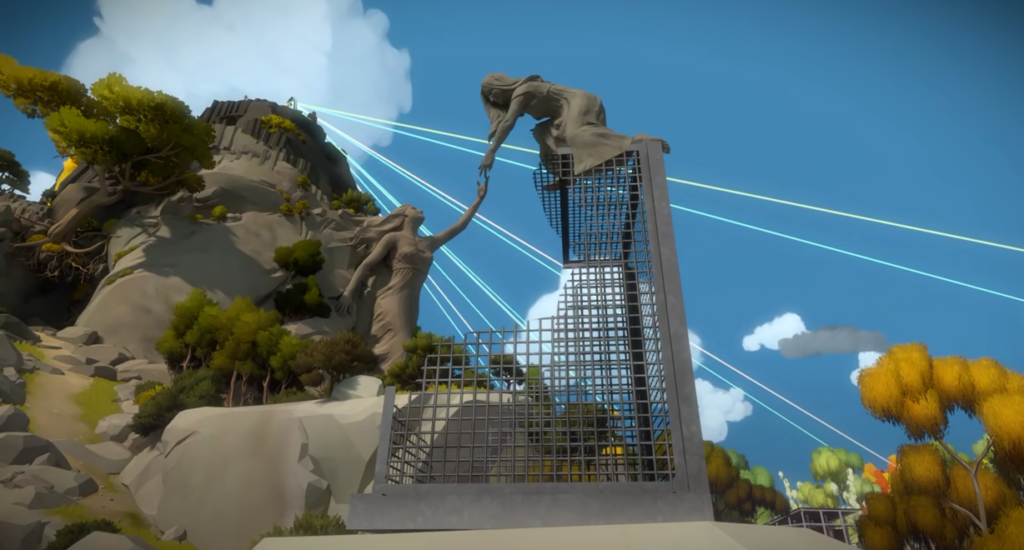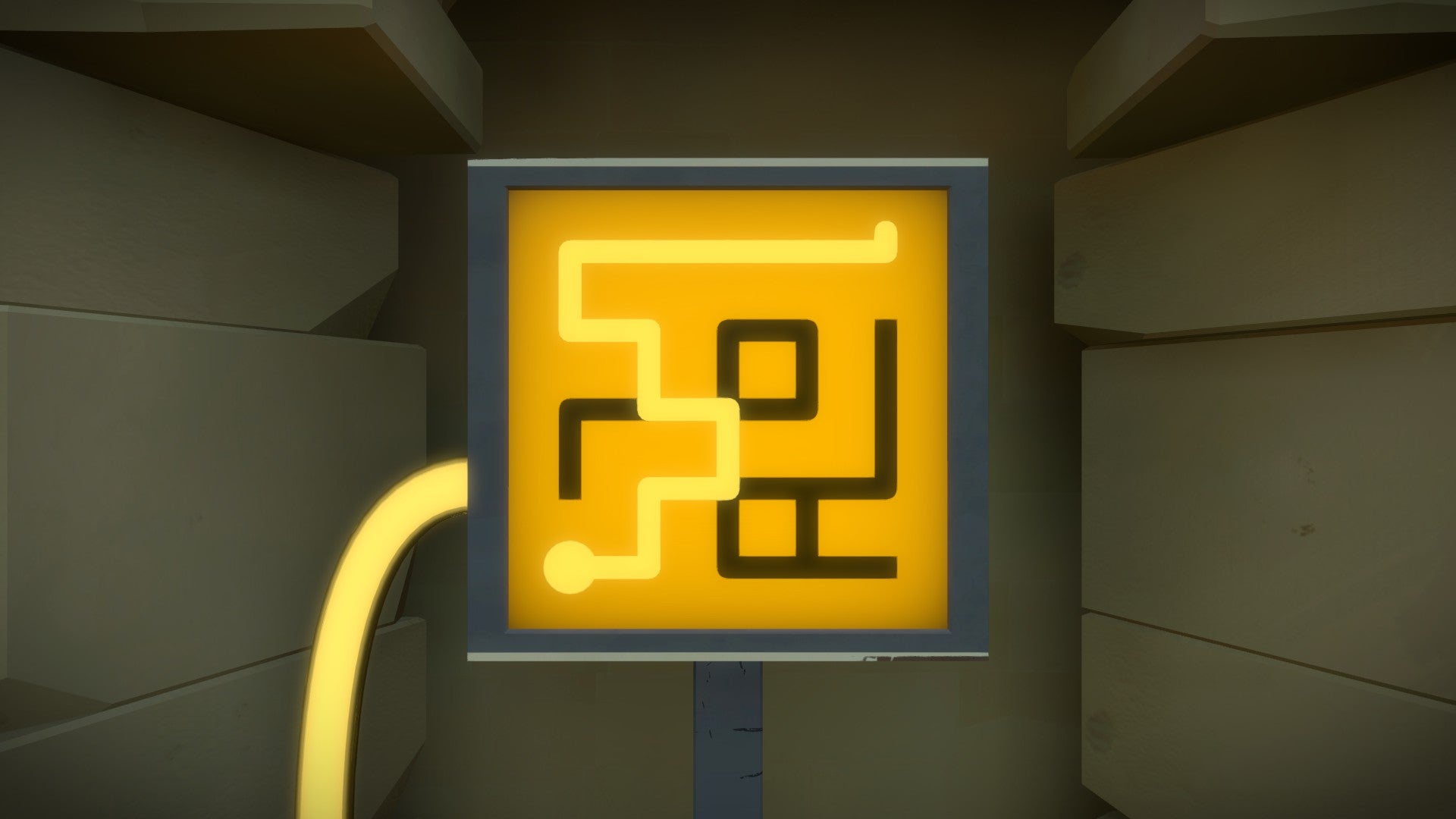Lots of games have multiple endings, and it’s often the case that a special ending that unlocks by collecting enough extra items (or similar) is referred to by the community as the “true ending”. Breath of the Wild has an extra ending cutscene if you defeat all the Divine Beasts and collect all the memories. Hollow Knight (minor spoiler warning) has an extra boss fight and drastically different ending if you collect some hard-to-find items and visit some extra story-related locations. Both of these endings are quite often referred to in the respective communities as the “true ending”. The case of Hollow Knight is interesting here since the developers themselves have pushed back against one ending being better than any others (the source was a reddit AMA, I can maybe find it). The name still sticks.
Metagames in Conversation with “True Endings”
It’s very interesting then to consider how this drive to find a “true ending” is deconstructed in some of the metagames we’ve played for class.
Save the Date provides the clearest candidate for a “true ending” of the games we played in class, but thinking about the hacker ending to the game even a little bit shows that it’s clearly not meant to be taken as the true ending for the game. Instead, the closest we can get to a “true ending” that matches the author’s stated intent for the game is the one where the player quits out of the game and imagines their own endings. Of course, when I reached that scene, I couldn’t bring myself to stop listening to what the author had to say in the game and write it myself, so I reached what is unquestionably a bad ending to the game. In the game-narrative version of the author smacking me in the face, the statue falls on Felicia and I’m told that I failed. Reaching this ending and getting a stronger feeling of failure than from any other point in the game is likely a pretty common experience. In this case, I think that Save the Date is trying to tell us a message that directly conflicts with my authorial-elevating interpretation of game stories.
In a different way, There Is No Game reaches a similar message. To the best of my knowledge, there are two endings to There Is No Game, both stemming from a binary choice (no spoilers) that the player has at the very end of the game. It’s possible that these choices actually lead to the same ending, but I don’t know because I don’t intend to play or watch through the option that I didn’t initially pick. But in the ending that I did pick, I tried to play the game again (instead of deleting the game’s source code) but it immediately blue-screened and Mr. Glitch escaped once again, presumably to *cough, cough… excuse me, sorry about that* … the world. This is undoubtedly a bad ending. Game (the character) is dead or similar, GG is either dead or heartbroken that Game is gone, and the rest of the world probably isn’t any better off.
Compare this to a different “ending” I could have gotten in the game, namely the one where I listened to Game’s requests at the beginning and simply left before ever searching for a game. Game would have continued wallowing without GG, but we can hope he would move on eventually. GG, I think, was actually pretty happy in the RPG GPS application, judging from the player being level 42 when we arrive. GG’s sad tone in the app when we find her contrasts with the chipper attitude of the game’s systems (“double XP weekend, happy looting!”), which suggests that GG before her dream-like encounter with Game was moving on and finding happiness at least to some extent. And of course, we can assume that Mr. Glitch would never have escaped from Game’s code and his evil plan would never be enacted.
Arguing somewhat adversarially, I think this is the closest we can get to a good ending. But I don’t think anyone could argue this is the “true ending” to the game. After all, aren’t “true endings” supposed to come after we experience the game to its fullest, finding all the story elements and engaging with the game to its fullest extent? This is one way that There Is No Game engages in the same conversation that Save the Date started with its refusal to provide a “true ending” in the way that players want one. One additional note that There Is No Game adds is the fact that it costs $12.99. That’s a sure reason to remove this ending as a possibility from all players’ minds — it would be a waste of money not to play!
Of course, there’s always the possibility that I’m completely wrong in this reading of There Is No Game. Maybe if I had pushed the other button in the final act, everything would have managed to work itself out nicely. Maybe Mr. Glitch self-destructs himself while stopping the delete process and then Game and GG live happily ever after. But I don’t intend to find out what happens, because I don’t think that the point of these games is to search for a happy ending. My experience with the story that the game told me personally is enough for me, and I think that’s a lesson that we should be able to take to more games than just the meta ones.
Some Additonal Reading
Major spoilers for The Witness to follow. This blog post is long already but I can’t not talk about The Witness here. Read on or not, but I’m not sure I recommend playing the entire game just to read my silly little thoughts about that silly little game.
I’d like to propose no fewer than four possible “true endings” for The Witness. Of course, I intend to find at the end that none of these should be read even as endings at all, and Jonathan Blow is just here to epically troll us just a little bit more.
The first true ending comes if you activate all 11 lasers from all the areas and complete the time trial underground at the bottom of the mountain, you gain access to the final recording code for the cinema room under the windmill. This seems the closest to what a “true ending” would be in a regular game — you mastered all the puzzles and beat the final gauntlet — but it just doesn’t give anything all that special. Entering the elevator after completing this elevator gives exactly the same cutscene as if you had done just 7 lasers. Clearly, this isn’t the true ending, so what is?
The next most obvious answer is the scene you can discover by completing an environmental puzzle in the tutorial area. It opens up to a secret room, supposedly pulling back the curtain to reveal that the entire game was actually just a video game being developed diegetically inside the game, and we watch a playtester stumble his way out of the VR environment and start to see more “environmental puzzles” in his reality. This definitely feels like a good “true ending” but I’d like to call some amount of BS on that reading. The Witness is full of objectively bad takes (see many of the hidden audio clips or the videos), and I think this is just one more of them. The “reveal” that the whole game was just a game-within-a-game is dissatisfying to many, and I think it’s just a device in the game meant to draw even more emphasis on the environmental puzzles inside the actual game. The fact that I never discovered this secret on my own playthrough may or may not affect my rejection of this as the “true ending”, but I’ll move on.
Granting that the game-within-a-game isn’t it and that we’re meant to focus further on the environmental puzzles, we can turn to the obelisks in the game that light up when you complete environmental puzzles. Perhaps the true meaning of the game is unlocked when we fill all of those out? If you’re starting to catch on, it’s not surprising that absolutely nothing happens when you finally complete the last obelisk. I this is still just as valid (or invalid) an ending as any of the others — environmental puzzles don’t ever do anything when you complete them, so maybe the ending is just the personal satisfaction you get for doing all of them. The fact that one of these puzzles takes about an hour to complete (if I recall correctly) hints that there’s something more going on here, but I don’t think it’s a “true ending”.
Our final candidate for the true ending is pretty far out there, but it’s something that Joseph Anderson starts to talk about in his video “The Witness — A Great Game That You Shouldn’t Play”. I don’t agree with much of what he says in his video, but (like the game is perhaps trying to tell us), maybe the video is still worth watching. What Joseph talks about is this idea shown in The Witness of perspective shifts. You shift your perspective when solving puzzles, when searching for environmental puzzles, and even, as Joesph describes in his experience in the game when just looking at the island.

I don’t really think this is was ever considered a “true ending” to the game. Nothing happens to tell you this is the end of the game, and there’s no way to even know you’ve found all of the visual puns and perspective shifts that the game might have set up for you. But it feels to me like a natural extension of our third “true ending” and I think it shows the foolishness that Blow is in conversation with about endings in games. There’s no good, satisfying ending to the game, and that’s ok. I don’t think the game was really meant to have one specific ending (just like the author of Save the Date said about his game), but I do think that the inherent failure in any quest to mine The Witness for a “true ending” was part of the intentional design of the game.
I don’t really know what I’m trying to say about The Witness. Maybe with more time or a longer-form space to write and organize my thoughts, I could come up with a better message. In general, though, it’s interesting to look at the way The Witness provides endings to the game, and even more generally I’m still very interested in the ways that all the meta-games we played (and then at least one we didn’t) are playing around with the idea in such different ways. Thanks for bearing with my rambling.

